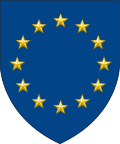Spanish Armed Forces
The Spanish Armed Forces are in charge of guaranteeing the sovereignty and independence of Spain, defending its territorial integrity and the constitutional order, according to the functions entrusted to them by the Constitution of 1978. They are composed of: the Army, the Air Force, the Navy, the Royal Guard and the Military Emergency Unit, as well as the so-called Common Corps.
| Spanish Armed Forces | |
|---|---|
| Fuerzas Armadas de España | |
 Badge of the Spanish Armed Forces | |
| Headquarters | Madrid, Spain |
| Leadership | |
| Commander-in-Chief | Capitán General King Felipe VI |
| Prime Minister | Pedro Sánchez |
| Minister of Defence | Margarita Robles |
| Chief of the Defence Staff | General Miguel Ángel Villarroya Vilalta |
| Manpower | |
| Military age | 18 |
| Active personnel | 120,350 (2019)[1] 75,800 Civil Guards (only in wartime) (2019)[1] |
| Reserve personnel | 15,150 (2019)[1] |
| Expenditures | |
| Budget | US$17.2 billion (2019)[2] |
| Percent of GDP | 1.2% (2019)[2] |
| Industry | |
| Domestic suppliers | Airbus, Santa Bárbara, Navantia, Indra, Gamesa, Abengoa, Instalaza, UROVESA |
| Foreign suppliers | |
| Annual exports | € 4.174 billion [3] (2010) |
| Related articles | |
| History | Military history of Spain |
| Ranks | Military ranks of Spain |
Spain is one of the most militarily powerful nations of the European Union (EUFOR) and Eurocorps. It also occupies a prominent position in the structure of the North Atlantic Treaty Organization (NATO), which it joined in 1982. It also has the oldest Marine Corps in the world and the oldest permanent military units in the world: the King's Immemorial No. 1 Infantry Regiment and the "Soria" No. 9 Light Infantry Regiment.
History
During the 15th and 16th century, Spain evolved into Europe's foremost power with the voyages of Christopher Columbus leading to Spain acquiring vast lands in the Americas. During the reign of Charles V and Philip II, Spain reached the peak of its power with the Spanish Empire spanning 19.4 million square km of the earth's surface, a total of 13%. By the mid 17th century this power had been weakened by the Thirty Years War along with financial problems, and the lack of reforms.
During the 18th century the new Bourbon dynasty revived Spain's economic and military power through a series of important reforms in the armed forces and the economy, notably those of Charles III of Spain. Thanks to these reforms, Spain performed well during the war of Jenkins' Ear, the war of Austrian Succession but with mixed result during the Seven Years' War. Spain had recovered considerably by the outbreak of the French Revolution. The occupation of a great part of Spain by the French during the Napoleonic Wars resulted in the so-called war of Spanish independence, which was characterised by use on a large scale of guerrilla troops, made necessary by the war's devastating effect on the Spanish economy. Following the war, the Spanish military was in poor condition and political instability resulted in the loss of most of Spain's former colonies, except Cuba, Puerto Rico, and the Philippines. These too would be lost later in the Spanish–American War.
Today
Spain participated along with France, the United Kingdom, Italy, Denmark, the United States and Canada in the offensive against Moammar Gaddafi in Libya, contributing a tanker, 4 F-18 fighter jets, a frigate, a submarine and a surveillance aircraft, along with logistical support from the Naval Base of Rota and the Air Base of Morón.
Spain has belonged to NATO since 1982. The decision was ratified in a referendum in 1986 by the Spanish people. The conditions were the reduction of American military bases, no integration of Spain in the military structure of NATO, and the prohibition of introducing nuclear weapons in Spain.
- Armada de las Fuerzas Armadas del Reino de España
.jpg) El buque Juan Carlos I
El buque Juan Carlos I_hovers_in_for_a_landing_after_a_live_fire_exercise.jpg) AnAV-8B Harrier II
AnAV-8B Harrier II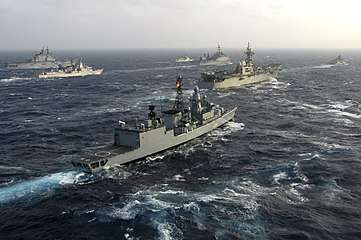 A formation of multi-nation ships
A formation of multi-nation ships
Current missions
As of June 2017, 3,093 soldiers of the Spanish Armed Forces and the Civil Guard are part of the nineteen operations where Spain has an active role.[4]
According to the National Security Department of Spain (DSN), these are the current missions of the armed forces and civil guard: [4]
- Missions with the European Union
- EUTM Mali (2013–present): Advisory mission in the security and training sector of the Malian National Army. 130 deployed military personnel.
- EUTM CAR (2016–present): Training mission of the Armed Forces of the Government of the Central African Republic. The Eurocorps is in charge of carrying out this mission. 19 military deployed.
- EUTM SOMALIA (2010–present): Training mission of the Somali Armed Forces, with the cooperation of the UN and the African Union. 16 military deployed.
- Operation Atalanta (2008–present): Mission to combat piracy in the Indian Ocean as well as protection of the UN food program. 338 deployed military.
- EUFOR ALTHEA BOSNIA (2004–present): Advisory mission to the Armed Forces of Bosnia and Herzegovina. 3 military deployed.
- EUNAVFOR MED-SOPHIA (2015–present): Mission to combat trafficking in human beings and prevention of loss of life in the Mediterranean. 261 deployed military personnel.
- Missions with NATO
- Operation Sea Guardian (2016–present): Mission to fight against terrorism in the Mediterranean. 119 military deployed.
- SNMG1 / SNMG2 / SNMCMG2: NATO first-responder permanent naval units. 251 deployed military personnel.
- Baltic Air Policing (2004–present): Mission to protect the airspace of Estonia, Latvia and Lithuania. 128 deployed military personnel.
- Enhanced Forward Presence (2017–present): Mission of presence of NATO in the Baltic Sea region following the annexation of Crimea by Russia. 310 military deployed.
- Operation Active Fence (2015–present): Mission to reinforce Turkey's air defense against the threat of ballistic missiles from Syria. 149 deployed military personnel.
- RESOLUTE SUPPORT (2015–present): Training and advisory mission of the Afghan security forces. 19 military deployed.
- Missions with UN
- UNIFIL (2006–present): Peacekeeping Monitoring Mission between Lebanon and Israel. 620 soldiers and civil guards deployed.
- UN COLOMBIA (2016–present): Mission of observers of the peace process in Colombia. 14 deployed military personnel.
- Coalition against Daesh
- INHERENT RESOLVE (2015–present): Training mission of Iraqi forces to fight the Daesh. 463 soldiers and civil guards deployed.
- Security cooperation with France
- Support for Mali-Senegal (2013–present): Military support to France to facilitate air transport of French and EU operations in Mali and Sahel. 61 military deployed.
- Support for the Central African Republic (2013–present): Military support for France and the EU to facilitate air transport in its operations. 45 military deployed.
- National missions of cooperation with Senegal and Cape Verde
- Support for Senegal (2016–present): Cooperative security activities with other countries. 34 deployed military personnel.
- Support for Cape Verde (2016–present): Cooperative security activities with other countries. 59 deployed military personnel.
The Spanish Armed Forces also participated in the last few years in other missions, above all humanitarian and observation: in Albania in 1999, Mozambique in 2000, Republic of Macedonia in 2001, Haiti in 2004 and Indonesia in 2005. In 2006, Spain participated in Darfur (Sudan) by sending observers, and in the Democratic Republic of the Congo. Spain also participated in the Iraq War between 2003 and 2004, in Gabon and in Senegal to ensurence the maritim traffic in the Horn of Africa (in this one, with 33 civil guards and national police officers, two patrol vessels and a helicopter).[5] Furthermore, in 2015, 46 UME soldiers and 12 civil guards of the High Mountain Group went to help and rescue in the Nepal earthquake, along with six dogs, three scientific police and a Boeing 707 of supplies transport of the Air Force.[6][7]
The cost of these missions abroad amounts to approximately 800 million euros per year.[8]
Command structure
The commander in chief of the Armed Forces is the King of Spain; with the ex officio rank of Capitán General in the Army, Navy and Air Force. The Spanish Constitution of 1978 states in article 62(h) that the King of Spain shall have "supreme command of the Armed Forces"; however under article 64, all official acts of the King must be countersigned by the President of the Government (or other competent minister) to become valid.
The President of the Government (also known as Prime Minister in English translations), as the head of government, is responsible under article 97 for "domestic and foreign policy, civil and military administration and the defence of the State", and thus bears the ultimate responsibility before the Cortes Generales, and the Spanish electorate.
The Minister of Defence, a member of the Government, is in charge of running the Ministry of Defence which carries out the day-to-day administration of the forces. The President of the Government and the Minister of Defence are civilians. No provision in the Constitution requires the Government to seek approval from the Cortes Generales before sending the armed forces abroad.
The Chief of the Defense Staff is the Spanish equivalent of a chief of defence, directs the Defense Staff and is the senior military advisor to the Minister and the Government. The military leadership of the three military services are: the Chief of Staff of the Army, the Chief of Staff of the Air Force and the Chief of Staff of the Navy.
The structure is:

.svg.png)
.svg.png)

- The Chiefs of Staff of the branches:

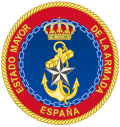
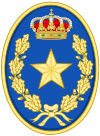
Branches
The Spanish armed forces are a professional force with a strength in 2017 of 121,900 active personnel and 4,770 reserve personnel. The country also has the 77,000 strong Civil Guard which comes under the control of the Ministry of Defence in times of a national emergency. The Spanish defence budget is 5.71 billion euros (US$7.2 billion) a 1% increase for 2015. The increase comes because of security concerns in the country.[9]
Army
The Spanish army consists of 15 active brigades and 6 military regions. Modern infantry have diverse capabilities and this is reflected in the varied roles assigned to them. There are four operational roles that infantry battalions can fulfil: air assault, armoured infantry, mechanised infantry, and light role infantry. The Spanish army has the latest technology at its disposal to preserve the territorial integrity of the Kingdom of Spain.[10]
Navy
Under the command of the Spanish Admiral Chief of Naval Staff, stationed in Madrid, are four area commands:
- Cantabrian Maritime Zone with its headquarters at Ferrol on the Atlantic coast
- Straits Maritime Zone with its headquarters at San Fernando near Cadiz
- Mediterranean Maritime Zone with its headquarters at Cartagena
- Canary Islands Maritime Zone with its headquarters at Las Palmas de Gran Canaria.
The current flagship of the Spanish Navy is the amphibious assault ship Juan Carlos 1 which is also used as an aircraft carrier. In addition, the fleet consists of: 2 amphibious transport docks, 11 frigates, 3 submarines, 6 mine countermeasure vessels, 23 patrol vessels and a number of auxiliary ships. The total displacement of the Spanish Navy is approximately 220,000 tonnes. As of 2012, the Armada has a strength of 20,838 personnel.[11]
Marines
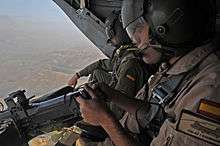
The Marines, in Spanish, Infanteria de Marina, are the marine infantry of the Spanish Navy, the oldest in the world. It has a strength of 5,000 troops divided into base defense forces and landing forces. One of the three base defense battalions is stationed with each of the Navy headquarters. "Groups" (midway between battalions and regiments) are stationed in Madrid and Las Palmas de Gran Canaria. The Tercio (fleet — regiment equivalent) is available for immediate embarkation and based out of San Fernando. Its principal weapons include light tanks, armored personnel vehicles, self-propelled artillery, and TOW and Dragon antitank missiles.
Air Force
Spain currently has 10 fighter squadrons, each with 18-24 airplanes. The air force also has 15 operational air bases around the country. The air force operates a wide-ranging fleet of aircraft, from fighters to transport aircraft and passenger transports to helicopters. It maintains some 450 aircraft in total, of which around 130 are fighter aircraft, including a number of Eurofighter Typhoons. The Spanish Air Force is replacing older aircraft in the inventory with newer ones including the recently introduced Eurofighter Typhoon and the Airbus A400M Atlas airlifter. Both are manufactured with Spanish participation; EADS CASA makes the Eurofighter's right wing and leading edge slats, and participates in the testing and assembly of the airlifter.[12] Its aerobatic display team is the Patrulla Aguila, which flies the CASA C-101 Aviojet.Its helicopter display team, Patrulla Aspa, flies the Eurocopter EC-120 Colibrí. In July 2014 the Spanish Air Force joined the European Air Transport Command, headquartered at Eindhoven Airbase in the Netherlands.[13]
Common Corps
The Common Corps are four corps that provide professional services to all the branches of the Armed Forces and the Civil Guard. The Common Corps where created in the 1980s to unify the specialist corps of the different branches for operational reasons. The Common Corps are:
- Military Legal Corps
- Military Comptroller Corps
- Military Medical Corps
- Military Band Corps
Royal Guard
The Royal Guard (Guardia Real) is an independent unit of the Spanish Armed Forces whose primary task is the military protection of the King of Spain and the Spanish Royal Family. It also protects visiting Heads of State.
The Royal Guard's history dates back to medieval times, the Corps of Gentlemen of the Chamber, the "Monteros de Espinosa", dating to 1006.
It currently has a strength of 1,900 troops, constituting a fully functional combat unit drawn from the ranks of all three branches of the Spanish Armed Forces: among others, a Marines company, a Paratroop company and an infantry company. Some units have served recently in Afghanistan and Bosnia.
Military Emergencies Unit
_(15352038639).jpg)
The Military Emergencies Unit (Spanish: Unidad Militar de Emergencias, is the most recently instituted branch of the Spanish Armed Forces, resulting from a decision of the Council of Ministers of Spain in 2005.
In addition to headquarters staff (Unidad de Cuartel General, there are five emergency intervention battalions (Batallon de Intervención en Emergencias, BIEM), a support regiment (Regimiento de Apoyo a Emergencias) and an aerial group (Agrupación de Medios Aéreos).
It is responsible for providing disaster relief principally throughout Spain but also if necessary abroad. The activities including handling natural hazards such as floods and earthquakes, forest fires, chemical and nuclear accidents, and other emergency situations recognized as such by the Prime Minister of Spain.
Citations
- IISS 2020, p. 145.
- Tian, Nan; Fleurant, Aude; Kuimova, Alexandra; Wezeman, Pieter D.; Wezeman, Siemon T. (27 April 2020). "Trends in World Military Expenditure, 2019" (PDF). Stockholm International Peace Research Institute. Retrieved 27 April 2020.
- "Archived copy" (PDF) (in Spanish). Archived from the original (PDF) on 2015-02-17. Retrieved 2015-02-16.CS1 maint: archived copy as title (link)
- "Fuerzas Armadas españolas en misiones internacionales, Junio 2017". 2017. Archived from the original on June 17, 2017. Retrieved June 19, 2017.
- "Misiones en curso". April 9, 2017. Archived from the original on April 14, 2015.
- "Medio centenar de militares españoles parten desde Jaca rumbo a Nepal". May 5, 2015. Archived from the original on October 28, 2017. Retrieved June 19, 2017.
- "Medio centenar de militares españoles parten desde Jaca rumbo a Nepal". May 5, 2015. Archived from the original on October 28, 2017. Retrieved June 19, 2017.
- Press, Europa (20 December 2016). "España gastó en 2016 más de 770 millones de euros en las misiones de las Fuerzas Armadas". Archived from the original on 8 June 2017. Retrieved 19 June 2017.
- "Update: Spain to increase defence spending". janes.com. Archived from the original on 18 May 2015. Retrieved 8 May 2015.
- "Snapshot: the Spanish defence industry to 2015". army-technology.com. Archived from the original on 7 August 2015. Retrieved 8 May 2015.
- "Military Budget 2012" (PDF). defensa.gov.es (in Spanish). p. 454. Archived (PDF) from the original on 2013-01-25. Retrieved 2013-02-12.
- http://www.airbus.com/en/presscentre/pressreleases/press-release/detail/first-a400m-wings-delivered-to-final-assembly-line/news-browse/1/news-period/1175378400/2591999/archived/news-category/press_release/?tx_felogin_pi1%5Bforgot%5D=1%5B%5D
- "Spain is now member of the EATC - Articles - EATC - European Air Transport Command". eatc-mil.com. Archived from the original on 7 July 2014. Retrieved 8 May 2015.
References
- IISS (2020). The Military Balance 2020. Routledge. ISBN 978-0367466398.
Further reading
- Jane's Defence Weekly, Country Survey: Spain, JDW 18 April 1992, p. 655-onwards
External links
- (in Spanish) Foro Militar General - Spanish Military forum
.jpg)

